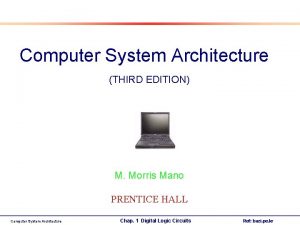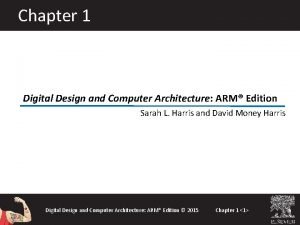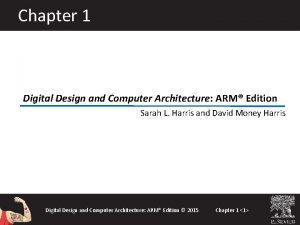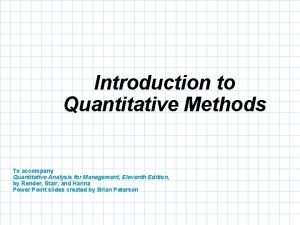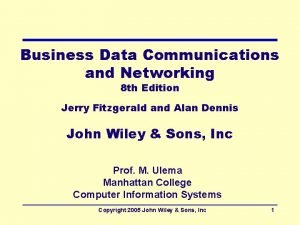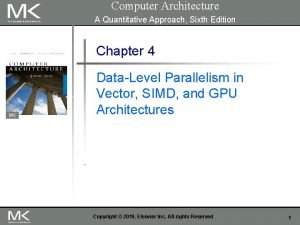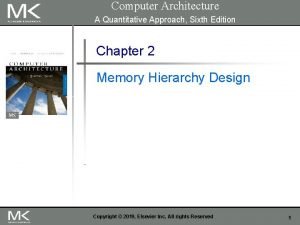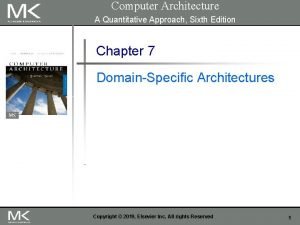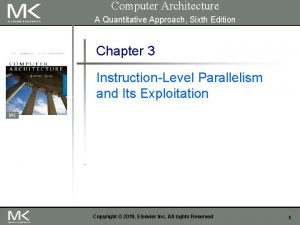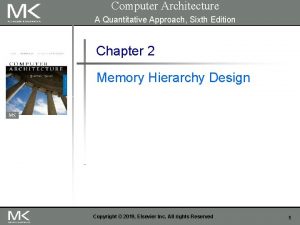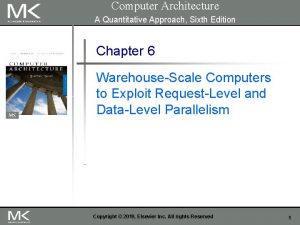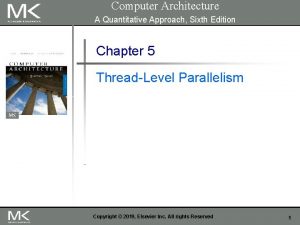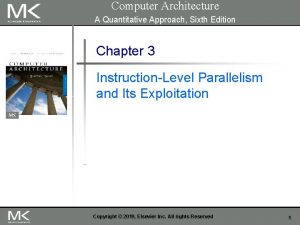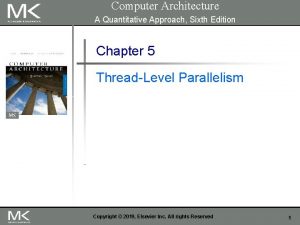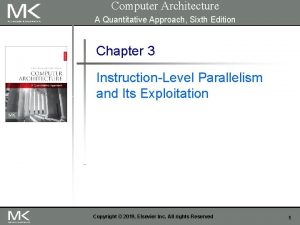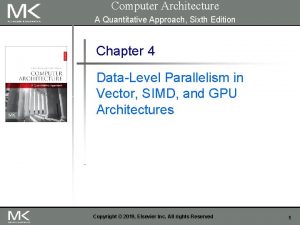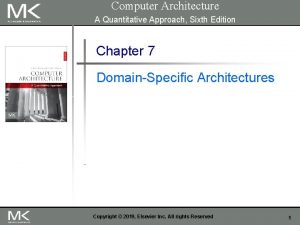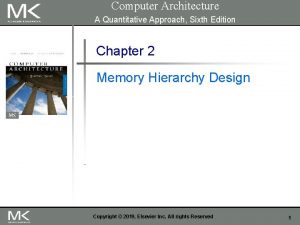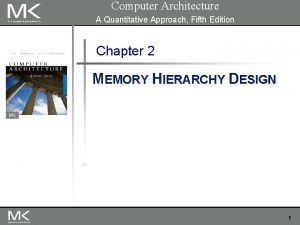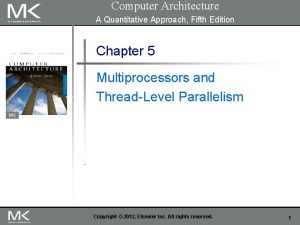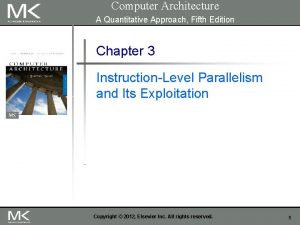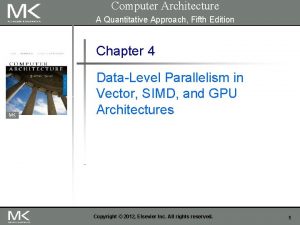Computer Architecture A Quantitative Approach Sixth Edition Chapter

















































- Slides: 49

Computer Architecture A Quantitative Approach, Sixth Edition Chapter 5 Thread-Level Parallelism We are dedicating all of our future product development to multicore designs. We believe this is a key inflection point for the industry--Paul Otellini, President, Intel, 2005 Copyright © 2019, Elsevier Inc. All rights Reserved 1

n Thread-Level parallelism n n n Introduction Have multiple program counters Uses MIMD model Targeted for tightly-coupled shared-memory multiprocessors For n processors, need n threads Amount of computation assigned to each thread = grain size n Threads can be used for data-level parallelism, but the overheads may outweigh the benefit Copyright © 2019, Elsevier Inc. All rights Reserved 2

n Symmetric multiprocessors (SMP) n n n Introduction Types Small number of cores Share single memory with uniform memory latency Distributed shared memory (DSM) n n n Memory distributed among processors Non-uniform memory access/latency (NUMA) Processors connected via direct (switched) and nondirect (multi-hop) interconnection networks Copyright © 2019, Elsevier Inc. All rights Reserved 3

Figure 5. 1 Basic structure of a centralized shared-memory multiprocessor based on a multicore chip. Multiple processor-cache subsystems share the same physical memory, typically with one level of shared cache on the multicore, and one or more levels of private per-core cache. The key architectural property is the uniform access time to all of the memory from all of the processors. In a multichip design, an interconnection network links the processors and the memory, which may be one or more banks. In a single-chip multicore, the interconnection network is simply the memory bus. 4

Figure 5. 2 The basic architecture of a distributed-memory multiprocessor in 2017 typically consists of a multicore multiprocessor chip with memory and possibly I/O attached an interface to an interconnection network that connects all the nodes. Each processor core shares the entire memory, although the access time to the local memory attached to the core's chip will be much faster than the access time to remote memories. 5

n Processors may see different values through their caches: Copyright © 2019, Elsevier Inc. All rights Reserved Centralized Shared-Memory Architectures Cache Coherence 6

n Coherence n n n All reads by any processor must return the most recently written value Writes to the same location by any two processors are seen in the same order by all processors Consistency n n Centralized Shared-Memory Architectures Cache Coherence When a written value will be returned by a read If a processor writes location A followed by location B, any processor that sees the new value of B must also see the new value of A Copyright © 2019, Elsevier Inc. All rights Reserved 7

n Coherent caches provide: n n n Migration: movement of data Replication: multiple copies of data Cache coherence protocols n Directory based n n Sharing status of each block kept in one location Snooping n Centralized Shared-Memory Architectures Enforcing Coherence Each core tracks sharing status of each block Copyright © 2019, Elsevier Inc. All rights Reserved 8

n Write invalidate n n On write, invalidate all other copies Use bus itself to serialize n n Write cannot complete until bus access is obtained Centralized Shared-Memory Architectures Snoopy Coherence Protocols Write update n On write, update all copies Copyright © 2019, Elsevier Inc. All rights Reserved 9

Figure 5. 4 An example of an invalidation protocol working on a snooping bus for a single cache block (X) with write-back caches. We assume that neither cache initially holds X and that the value of X in memory is 0. The processor and memory contents show the value after the processor and bus activity have both completed. A blank indicates no activity or no copy cached. When the second miss by B occurs, processor A responds with the value canceling the response from memory. In addition, both the contents of B's cache and the memory contents of X are updated. This update of memory, which occurs when a block becomes shared, simplifies the protocol, but it is possible to track the ownership and force the write-back only if the block is replaced. This requires the introduction of an additional status bit indicating ownership of a block. The ownership bit indicates that a block may be shared for reads, but only the owning processor can write the block, and that processor is responsible for updating any other processors and memory when it changes the block or replaces it. If a multicore uses a shared cache (e. g. , L 3), then all memory is seen through the shared cache; L 3 acts like the memory in this example, and coherency must be handled for the private L 1 and L 2 caches for each core. It is this observation that led some designers to opt for a directory protocol within the multicore. To make this work, the L 3 cache must be inclusive; recall from Chapter 2, that a cache is inclusive if any location in a higher level cache (L 1 and L 2 in this case) is also in L 3. We return to the topic of inclusion on page 423. 10

n Locating an item when a read miss occurs n n In write-back cache, the updated value must be sent to the requesting processor Cache lines marked as shared or exclusive/modified n Only writes to shared lines need an invalidate broadcast n Centralized Shared-Memory Architectures Snoopy Coherence Protocols After this, the line is marked as exclusive Copyright © 2019, Elsevier Inc. All rights Reserved 11

Copyright © 2019, Elsevier Inc. All rights Reserved Centralized Shared-Memory Architectures Snoopy Coherence Protocols 12

Figure 5. 5 The cache coherence mechanism receives requests from both the core's processor and the shared bus and responds to these based on the type of request, whether it hits or misses in the local cache, and the state of the local cache block specified in the request. The fourth column describes the type of cache action as normal hit or miss (the same as a uniprocessor cache would see), replacement (a uniprocessor cache replacement miss), or coherence (required to maintain cache coherence); a normal or replacement action may cause a coherence action depending on the state of the block in other caches. For read, misses, write misses, or invalidates snooped from the bus, an action is required only if the read or write addresses match a block in the local cache and the block is valid. 13

Copyright © 2019, Elsevier Inc. All rights Reserved Centralized Shared-Memory Architectures Snoopy Coherence Protocols 14

Figure 5. 6 A write invalidate, cache coherence protocol for a private write-back cache showing the states and state transitions for each block in the cache. The cache states are shown in circles, with any access permitted by the local processor without a state transition shown in parentheses under the name of the state. The stimulus causing a state change is shown on the transition arcs in regular type, and any bus actions generated as part of the state transition are shown on the transition arc in bold. The stimulus actions apply to a block in the private cache, not to a specific address in the cache. Thus a read miss to a block in the shared state is a miss for that cache block but for a different address. The left side of the diagram shows state transitions based on actions of the processor associated with this cache; the right side shows transitions based on operations on the bus. A read miss in the exclusive or shared state and a write miss in the exclusive state occur when the address requested by the processor does not match the address in the local cache block. Such a miss is a standard cache replacement miss. An attempt to write a block in the shared state generates an invalidate. Whenever a bus transaction occurs, all private caches that contain the cache block specified in the bus transaction take the action dictated by the right half of the diagram. The protocol assumes that memory (or a shared cache) provides data on a read miss for a block that is clean in all local caches. In actual implementations, these two sets of state diagrams are combined. In practice, there are many subtle variations on invalidate protocols, including the introduction of the exclusive unmodified state, as to whether a processor or memory provides data on a miss. In a multicore chip, the shared cache (usually L 3, but sometimes L 2) acts as the equivalent of memory, and the bus is the bus between the private caches of each core and the shared cache, which in turn interfaces to the memory. 15

Figure 5. 7 Cache coherence state diagram with the state transitions induced by the local processor shown in black and by the bus activities shown in gray. As in Figure 5. 6, the activities on a transition are shown in bold. 16

n Complications for the basic MSI Modified. Shared. Invalid protocol: n Operations are not atomic n n E. g. detect miss, acquire bus, receive a response Creates possibility of deadlock and races One solution: processor that sends invalidate can hold bus until other processors receive the invalidate Extensions: n Add exclusive state to indicate clean block in only one cache (MESI protocol) Adds Exclusive state (reduce traffic if block is needed by only one cache) – One of several refinements. n n Centralized Shared-Memory Architectures Snoopy Coherence Protocols Prevents needing to write invalidate on a write Owned state Copyright © 2019, Elsevier Inc. All rights Reserved 17

n Shared memory bus and snooping bandwidth is bottleneck for scaling symmetric multiprocessors n n n Duplicating tags Place directory in outermost cache Use crossbars or pointto-point networks with banked memory Copyright © 2019, Elsevier Inc. All rights Reserved Centralized Shared-Memory Architectures Coherence Protocols: Extensions 18

Figure 5. 8 A single-chip multicore with a distributed cache. In current designs, the distributed shared cache is usually L 3, and levels L 1 and L 2 are private. There are typically multiple memory channels (2– 8 in today's designs). This design is NUCache. A, since the access time to L 3 portions varies with faster access time for the directly attached core. Because it is NUCA, it is also NUMA. 19

n Every multicore with >8 processors uses an interconnect other than bus n n n Makes it difficult to serialize events Write and upgrade misses are not atomic How can the processor know when all invalidates are complete? How can we resolve races when two processors write at the same time? Solution: associate each block with a single bus Copyright © 2019, Elsevier Inc. All rights Reserved Centralized Shared-Memory Architectures Coherence Protocols 20

n Coherence influences cache miss rate n Coherence misses n True sharing misses n n n Write to shared block (transmission of invalidation) Read an invalidated block False sharing misses n Read an unmodified word in an invalidated block Copyright © 2019, Elsevier Inc. All rights Reserved Performance of Symmetric Shared-Memory Multiprocessors Performance 21

Copyright © 2019, Elsevier Inc. All rights Reserved Performance of Symmetric Shared-Memory Multiprocessors Performance Study: Commercial Workload 22

Copyright © 2019, Elsevier Inc. All rights Reserved Performance of Symmetric Shared-Memory Multiprocessors Performance Study: Commercial Workload 23

Copyright © 2019, Elsevier Inc. All rights Reserved Performance of Symmetric Shared-Memory Multiprocessors Performance Study: Commercial Workload 24

Copyright © 2019, Elsevier Inc. All rights Reserved Performance of Symmetric Shared-Memory Multiprocessors Performance Study: Commercial Workload 25

n Snooping schemes require communication among all caches on every cache miss n n Limits scalability Another approach: Use centralized directory to keep track of every block n n n Which caches have each block Dirty status of each block Implement in shared L 3 cache n n Keep bit vector of size = # cores for each block in L 3 Not scalable beyond shared L 3 Copyright © 2019, Elsevier Inc. All rights Reserved Distributed Shared Memory and Directory-Based Coherence Directory Protocols 26

n Alternative approach: n Distribute memory Copyright © 2019, Elsevier Inc. All rights Reserved Distributed Shared Memory and Directory-Based Coherence Directory Protocols 27

Figure 5. 18 A directory is added to each node to implement cache coherence in a distributedmemory multiprocessor. In this case, a node is shown as a single multicore chip, and the directory information for the associated memory may reside either on or off the multicore. Each directory is responsible for tracking the caches that share the memory addresses of the portion of memory in the node. The coherence mechanism will handle both the maintenance of the directory information and any coherence actions needed within the multicore node. 28

n For each block, maintain state: n Shared n n Uncached Modified n n One or more nodes have the block cached, value in memory is up-to-date Set of node IDs Exactly one node has a copy of the cache block, value in memory is out-of-date Owner node ID Directory maintains block states and sends invalidation messages Go to text slides following Fig. 5. 21 Copyright © 2019, Elsevier Inc. All rights Reserved Distributed Shared Memory and Directory-Based Coherence Directory Protocols 29

Copyright © 2019, Elsevier Inc. All rights Reserved Distributed Shared Memory and Directory-Based Coherence Messages 30

Figure 5. 19 The possible messages sent among nodes to maintain coherence, along with the source and destination node, the contents (where P = requesting node number, A = requested address, and D = data contents), and the function of the message. The first three messages are requests sent by the local node to the home. The fourth through sixth messages are messages sent to a remote node by the home when the home needs the data to satisfy a read or write miss request. Data value replies are used to send a value from the home node back to the requesting node. Data value write-backs occur for two reasons: when a block is replaced in a cache and must be written back to its home memory, and also in reply to fetch or fetch/invalidate messages from the home. Writing back the data value whenever the block becomes shared simplifies the number of states in the protocol because any dirty block must be exclusive and any shared block is always available in the home memory. 31

Copyright © 2019, Elsevier Inc. All rights Reserved Distributed Shared Memory and Directory-Based Coherence Directory Protocols 32

Figure 5. 20 State transition diagram for an individual cache block in a directory-based system. Requests by the local processor are shown in black, and those from the home directory are shown in gray. Only in the reference to Figure 5. 20 in the text: [Requests coming from outside the node in gray] and actions in black. The states are identical to those in the snooping case, and the transactions are very similar, with explicit invalidate and write-back requests replacing the write misses that were formerly broadcast on the bus. As we did for the snooping controller, we assume that an attempt to write a shared cache block is treated as a miss; in practice, such a transaction can be treated as an ownership request or upgrade request and can deliver ownership without requiring that the cache block be fetched. 33

Figure 5. 21 The state transition diagram for the directory has the same states and structure as the transition diagram for an individual cache. All actions are in gray because they are all externally caused. Bold indicates the action taken by the directory in response to the request. If there is anything in bold it is not as distinguishable as in Fig 5. 20 34

n For uncached block: n Read miss n n Write miss n n Requesting node is sent the requested data and is made the only sharing node, block is now shared The requesting node is sent the requested data and becomes the sharing node, block is now exclusive For shared block: n Read miss n n The requesting node is sent the requested data from memory, node is added to sharing set Write miss n The requesting node is sent the value, all nodes in the sharing set are sent invalidate messages, sharing set only contains requesting node, block is now exclusive Copyright © 2019, Elsevier Inc. All rights Reserved Distributed Shared Memory and Directory-Based Coherence Directory Protocols 35

n For exclusive block: n Read miss n n Data write back n n The owner is sent a data fetch message, block becomes shared, owner sends data to the directory, data written back to memory, sharers set contains old owner and requestor Block becomes uncached, sharer set is empty Write miss n Message is sent to old owner to invalidate and send the value to the directory, requestor becomes new owner, block remains exclusive Copyright © 2019, Elsevier Inc. All rights Reserved Distributed Shared Memory and Directory-Based Coherence Directory Protocols 36

n Basic building blocks: n Atomic exchange n n Test-and-set n n n Sets under condition Fetch-and-increment n n Swaps register with memory location Synchronization Reads original value from memory and increments it in memory Requires memory read and write in uninterruptable “atomic” instruction RISC-V: load reserved/store conditional n If the contents of the memory location specified by the load linked are changed before the store conditional to the same address, the store conditional fails My understanding: RISC-V replaces a simple failure of acquiring a lock by one of two possible failures (top of p. 417 in textbook) for minimizing bus traffic. Copyright © 2019, Elsevier Inc. All rights Reserved 37

Fetch&Increment example F&I (x 1, x 2): Atomically: x 1: =x 1+x 2; x 2: =x 1 [right side: old values] Suppose: threads executing concurrently comprise the following commands - Thread(/Processor) 1: F&I(x 1, x 2 - Thread(/Processor) 2: F&I(x 1, x 3) - there are no other write commands into x 1, x 2, x 3 What are their possible value when done? Assuming associativity of “increment”: x 1=x 1+x 2+x 3 Two possibilities: (i) x 2=x 1 and x 3=x 1+x 2, or (ii) x 3=x 1 and x 2=x 1+x 3 Now, if x 1=0 and x 2=x 3=1, then exactly one of x 2, x 3 will be 1 and exactly one will be 2. Can be used for: (i) “mutual exclusion”: one thread of execution never enters its critical section at the same time that another concurrent thread of execution enters its own critical section; (ii) locks. Copyright © 2019, Elsevier Inc. All rights Reserved 38

n Atomic exchange (EXCH): try: n mov x 3, x 4 lr x 2, x 1 sc x 3, 0(x 1) bnez x 3, try mov x 4, x 2 ; mov exchange value ; load reserved from ; store conditional ; branch store fails ; put load value in x 4? Synchronization Implementing Locks Atomic increment: try: lr x 2, x 1 addi x 3, x 2, 1 sc x 3, 0(x 1) bnez x 3, try ; load reserved 0(x 1) ; increment ; store conditional ; branch store fails Copyright © 2019, Elsevier Inc. All rights Reserved 39

n Lock (no cache coherence) lockit: n addi x 2, R 0, #1 EXCH x 2, 0(x 1) bnez x 2, lockeit Synchronization Implementing Locks ; atomic exchange ; already locked? Lock (cache coherence): lockit: ld x 2, 0(x 1) bnez x 2, lockeit addi x 2, R 0, #1 EXCH x 2, 0(x 1) bnez x 2, lockeit ; load of lock ; not available-spin ; load locked value ; swap ; branch if lock wasn’t 0 Copyright © 2019, Elsevier Inc. All rights Reserved 40

n Advantage of this scheme: reduces memory traffic Copyright © 2019, Elsevier Inc. All rights Reserved Synchronization Implementing Locks 41

Processor 1: A=0 … A=1 if (B==0) … n Should be impossible for both if-statements to be evaluated as true n n Processor 2: B=0 … B=1 if (A==0) … Delayed write invalidate? Sequential consistency: n Result of execution should be the same as long as: n n Models of Memory Consistency: An Introduction Models of Memory Consistency Accesses on each processor were kept in order Accesses on different processors were arbitrarily interleaved Copyright © 2019, Elsevier Inc. All rights Reserved 42

n To implement, delay completion of all memory accesses until all invalidations caused by the access are completed n n Reduces performance! Alternatives: n Program-enforced synchronization to force write on processor to occur before read on the other processor n Requires synchronization object for A and another for B n n Models of Memory Consistency: An Introduction Implementing Locks “Unlock” after write “Lock” after read Copyright © 2019, Elsevier Inc. All rights Reserved 43

Figure 5. 23 The orderings imposed by various consistency models are shown for both ordinary accesses and synchronization accesses. The models grow from most restrictive (sequential consistency) to least restrictive (release consistency), allowing increased flexibility in the implementation. The weaker models rely on fences created by synchronization operations, as opposed to an implicit fence at every memory operation. SA and SR stand for acquire and release operations, respectively, and are needed to define release consistency. If we were to use the notation SA and SR for each S consistently, each ordering with one S would become two orderings (e. g. , S → W becomes SA → W, SR → W), and each S → S would become the four orderings shown in the last line of the bottom-right table entry. 44

n Rules: n X→Y n n Operation X must complete before operation Y is done Sequential consistency requires: n n Relax W → R n n “Total store ordering” Relax W → W n n R → W, R → R, W → W “Partial store order” Models of Memory Consistency: An Introduction Relaxed Consistency Models Relax R → W and R → R n “Weak ordering” and “release consistency” Copyright © 2019, Elsevier Inc. All rights Reserved 45

Copyright © 2019, Elsevier Inc. All rights Reserved Models of Memory Consistency: An Introduction Relaxed Consistency Models 46

n n n Consistency model is multiprocessor specific Programmers will often implement explicit synchronization Speculation gives much of the performance advantage of relaxed models with sequential consistency n Basic idea: if an invalidation arrives for a result that has not been committed, use speculation recovery Copyright © 2019, Elsevier Inc. All rights Reserved Models of Memory Consistency: An Introduction Relaxed Consistency Models 47

Figure 5. 26 Summary of the characteristics of three recent high-end multicore processors (2015– 2017 releases) designed for servers. The table shows the range of processor counts, clock rates, and cache sizes within each processor family. The Power 8 L 3 is a NUCA (Nonuniform Cache Access) design, and it also supports off-chip L 4 of up to 128 Mi. B using EDRAM. A 32 -core Xeon has recently been announced, but no system shipments have occurred. The Fujitsu SPARC 64 is also available as an 8 -core design, which is normally configured as a single processor system. The last row shows the range of configured systems with published performance data (such as SPECint. Rate) with both processor chip counts and total core counts. The Xeon systems include multiprocessors that extend the basic interconnect with additional logic; for example, using the standard Quickpath interconnect limits the processor count to 8 and the largest system to 8 × 24 = 192 cores, but SGI extends the interconnect (and coherence mechanisms) with extra logic to offer a 32 processor system using 18 -core processor chips for a total size of 576 cores. Newer releases of these processors increased clock rates (significantly in the Power 8 case, less so in others) and core counts (significantly in the case of Xeon). 48

n n n Measuring performance of multiprocessors by linear speedup versus execution time Amdahl’s Law doesn’t apply to parallel computers Linear speedups are needed to make multiprocessors cost-effective n n Fallacies and Pitfalls Doesn’t consider cost of other system components Not developing the software to take advantage of, or optimize for, a multiprocessor architecture Copyright © 2019, Elsevier Inc. All rights Reserved 49
 Computer architecture a quantitative approach sixth edition
Computer architecture a quantitative approach sixth edition Computer architecture a quantitative approach sixth edition
Computer architecture a quantitative approach sixth edition Computer architecture a quantitative approach sixth edition
Computer architecture a quantitative approach sixth edition Computer architecture 5th edition
Computer architecture 5th edition Computer architecture a quantitative approach
Computer architecture a quantitative approach Computer architecture a quantitative approach
Computer architecture a quantitative approach Peter piper picked
Peter piper picked The sixth sick sheik's sixth sheep's sick lyrics
The sixth sick sheik's sixth sheep's sick lyrics Biochemistry sixth edition
Biochemistry sixth edition Automotive technology principles diagnosis and service
Automotive technology principles diagnosis and service Automotive technology sixth edition
Automotive technology sixth edition Apa sixth edition
Apa sixth edition Precalculus sixth edition
Precalculus sixth edition Rational people think at the margin
Rational people think at the margin Digital design and computer architecture
Digital design and computer architecture Computer circuit
Computer circuit Computer organization and architecture 10th edition
Computer organization and architecture 10th edition Computer architecture arm edition
Computer architecture arm edition Digital design and computer architecture: arm edition
Digital design and computer architecture: arm edition Buses in computer architecture
Buses in computer architecture Computer organization and computer architecture difference
Computer organization and computer architecture difference Design of a basic computer
Design of a basic computer Mis chapter 6
Mis chapter 6 Zulily case study
Zulily case study Define the concept of comparative education
Define the concept of comparative education Quantitative analysis for management excel qm
Quantitative analysis for management excel qm Quantitative approach to management
Quantitative approach to management Modes of speciation ppt
Modes of speciation ppt Cognitive theory child development
Cognitive theory child development Democritus atomic model diagram
Democritus atomic model diagram Systems architecture 7th edition
Systems architecture 7th edition Datagram network
Datagram network Cognitive approach vs behavioral approach
Cognitive approach vs behavioral approach What is preliminary and fine grain screening?
What is preliminary and fine grain screening? Multiple approach avoidance conflict
Multiple approach avoidance conflict Cognitive approach vs behavioral approach
Cognitive approach vs behavioral approach What is a research
What is a research Traditional approach in system analysis and design
Traditional approach in system analysis and design Deep learning approach and surface learning approach
Deep learning approach and surface learning approach Data and computer communications 10th edition
Data and computer communications 10th edition Computer security principles and practice 4th edition
Computer security principles and practice 4th edition Marking bad clusters data hiding technique
Marking bad clusters data hiding technique Computer networking 8th edition
Computer networking 8th edition Computer security fundamentals 4th edition
Computer security fundamentals 4th edition Guide to computer forensics and investigations 5th edition
Guide to computer forensics and investigations 5th edition Computer security principles and practice 4th edition
Computer security principles and practice 4th edition Nuast school holidays
Nuast school holidays Sixth form windsor
Sixth form windsor Wolf of shenfield
Wolf of shenfield Transition words for 6th grade
Transition words for 6th grade















